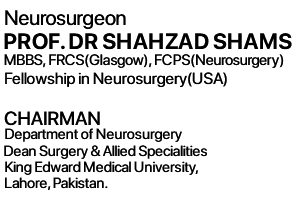Prof. Shahzad Shams presently works as Head and Professor of Neurosurgery Department at Lahore General Hospital, LGH, Lahore.
Endoscopic Treatment of Hydrocephalus
Latest Technique for Treatment of Hydrocephalus – Endoscopic Third Ventriculostomy – ETV
Endoscopic third ventriculostomy ETV done through a very small 2cm opening and hospital stay is for only 24 hours. Professor Shahzad Shams is one the best neurosurgeon for endoscopic third ventriculostomy ETV and an expert in endoscopic brain surgery.
Ventriculo – Peritoneal Shunt or VP Shunt Is Now an Obsolete Method of Treatment for Hydrocephalus
Hydrocephalus a condition in which the normal circulatory pathways of cerebrospinal fluid (CSF) are altered. Hydrocephalus can result from a number of conditions including congenital malformations, infection, hemorrhage, or brain tumors. With the accumulation of CSF, the intracranial pressure increases resulting in symptoms such as headache, vomiting, altered personality, and decreased cognitive performance. Hydrocephalus was previously treated by VP and VA shunts which had a significant rate of failure of tubing blockages and infections requiring frequent hospitalizations and additional surgery.
Endoscopic Third Ventriculostomy- ETV for Hydrocephalus
The procedure is performed through a small incision (approximately 1 inch) behind the hairline. Third ventriculostomy ETV done with endoscope through a very small 2cm opening and hospital stay is only for 24 hours. From this site, the endoscope is inserted into the ventricular compartment of the brain and then navigated into the third ventricle. The floor of this compartment is then fenestrated, or opened. The endoscope is then removed and the wound is closed. The procedure is performed in approximately 30 minutes and patients can return home the following day.
Advantages of Endoscopic Third Ventriculostomy
Advantage of this procedure is that no implanted shunt is needed thus avoiding the potential long-term risks of shunts including infection, migration, or disconnection.
Hospital Stay Is Only for 24 Hours.
Hydrocephalus/ Normal Pressure Hydrocepalus – NPH
It means an accumulation of fluid within the brain, and a concomittent rise in pressure within the head. Some of the more common causes of hydrocephalus include aqueduct stenosis, normal pressure hydrocephalus, hydrocephalus secondary to haemorrhage or infection, benign intracranial hypertension and arnold chiari malformation. Hydrocephalus can be investigated by a variety of means, including magnetic resonance imaging (MRI), to look at the ventricles within the head.
Once the diagnosis has been confirmed, treatment may involve diverting the excess fluid from the brain to the abdomen by implanting a device called a VP shunt( ventriculo-peritoneal shunt). These consist of a silicone tube, the flow along which is controlled by a valve. There are many different varieties of these, some of which can have the valve’s pressure setting externally adjusted by the treating consultant using an electromagnet.
Some types of hydrocephalus may be amenable to treatment with a neuro endoscope to create a drainage passage for the fluid within the brain itself this is the latest technique to treat NPH. This technique is called third ventriculostomy etv done with endoscope through a very small 2cm opening and hospital stay is only for 24 hours. More detail on hydrocephalus and ventriculo-peritoneal shunts can be found under the special topics menu.
Results:
The results of VP Shunt surgery are excellent.
Latest Technique for Treatment of Normal Pressure Hydrocephalus – ETV
Endoscopic third ventriculostomy ETV done through a very small 2cm opening and hospital stay is for only 24 hours. Professor Shahzad Shams is one the best neurosurgeon for endoscopic third ventriculostomy ETV which is minimally invasive keyhole surgery and he is an expert in endoscopic brain surgery.






